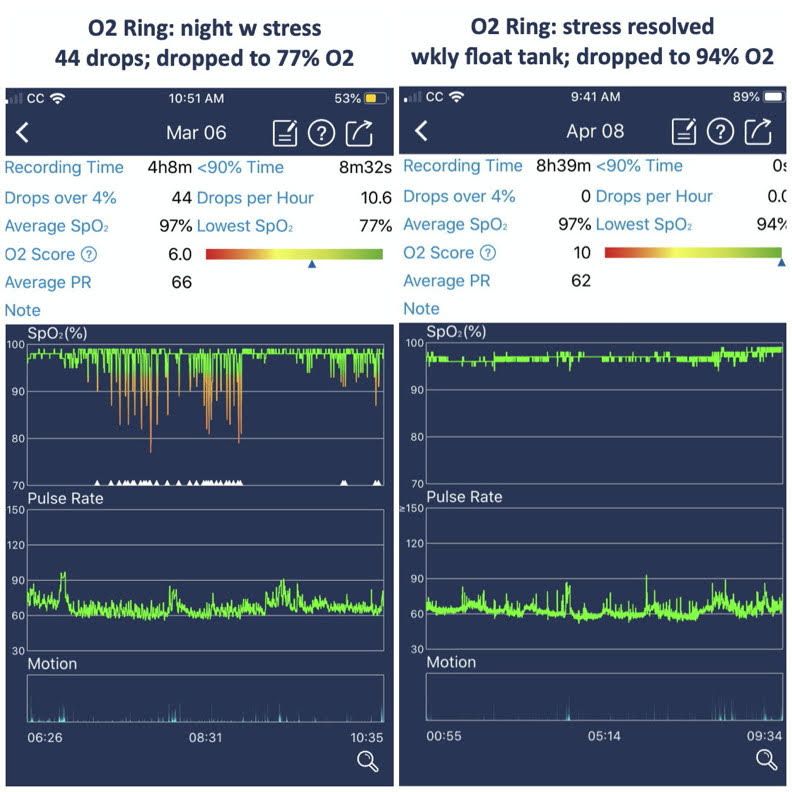Prior to floating, she would see numerous fluctuations in her O2 levels, sometimes dropping as many as 40 times per night. Afterwards, these consistent drops in O2 saturation disappeared. She was also feeling generally better – more rested and awake – and she was able to maintain
her energy both within and across days much more easily.
When Jeanine began to see rising blood oxygen levels throughout her sleep after she began floating, she started wondering how exactly floating might be contributing to this change. She wanted to know if floating was indeed helping with her oxygen levels, and if so, how?
This is where we run into some of the limits of personal stories and individually chronicled benefits. Without a controlled study across multiple groups of many participants, it’s unfortunately difficult to determine causation or even what a normal effect size might be. The science of floatation therapy is still a budding field, and it’s unsurprising that there haven’t been any long-term studies looking specifically at blood-oxygen levels, and what it is about floating that may cause them to rise.
However, hearing from people like Jeanine and observing the benefits that they seem to get from floating is incredibly useful for inspiring future research studies. After talking to her, and looking at her O2 levels, we definitely got excited about the potential to look into this aspect of floating in a more formal way. Until then, we only have our hypotheses.
The answer, for example, might lay in the makeup of float tank water, specifically the large concentration of magnesium. Although studying the actual transdermal absorption of magnesium has proven difficult to conduct, people still often look to the high concentration of magnesium as a potential source of many of the benefits reported by regular floaters.
People have been using hot springs for centuries to heal all kinds of ailments, from colds to body pain. While natural hot springs are filled with a variety of different minerals, the high concentration of magnesium has long been thought of as an important factor lending to the healing properties of these waters.
While well known and studied for its ability to relax muscles, it's possible that absorbing extra magnesium could help support other body functions as well. Magnesium is a very important and commonly used mineral for the body, and it indirectly supports the transfer of oxygen throughout
the body by aiding in production of red blood cells. Or, if the cause of Jeanine’s rising O2 levels isn’t Magnesium, perhaps it lies in the vagus nerve
and the overall stress reduction that floating provides. When she would notice her Oxygen levels dropping, Jeanine would regularly do something to trigger her vagus nerve – humming, in her case – which would stimulate her parasympathetic nervous system, and she would watch her oxygen levels rise. This got her wondering if floating was also activating her vagus nerve, and if that activation while in the tank was possibly carrying on into the night.
Alternatively, practicing and strengthening a healthier breathing rate might be responsible for her increased Oxygen levels. During her floats, Jeanine regularly noticed a dip in her breathing rate.
For some time, the commonly thought range for healthy breathing is 12-18 breaths per minute, but that is beginning to be challenged. At the rate of 12-18 breaths per minute, many people aren’t taking full enough breaths, and are instead breathing shallowly, and therefore not getting enough oxygen in (and carbon dioxide out of) the body.
During her time in the tank, Jeanine was regularly seeing a breathing rate of around 5 or 6 breaths per minute, which may be a more ideal rate, providing deeper, fuller breaths and providing a healthy amount of oxygen. At certain, especially deep parts of the float, her breathing dropped naturally to 3 breaths a minute, but her readings still showed that she was completely oxygenated.
The effects of stress levels can have strong and broad ranging impacts, and it’s also possible that the general stress relief that floating provides could itself be responsible for being able to maintain more normal O2 levels. When a home remodel took her time and attention from floating, she was feeling the tension rise. After four weeks of not floating, she could feel the effects of a lower blood oxygen level returning. “When my oxygen is low, I can feel it…it’s like a shortness of breath or like a fuzziness in my head.”
She experiences a loss of mental clarity, and can struggle to think through things. Combined with the stress of the remodel, she reached a point where she couldn’t take it. She scheduled four floats over the next four weeks, and soon she was back to feeling clear headed and more aware again.
It’s also entirely possible that it is a combination of various factors, rather than one distinct quality of floating, that are contributing to Jeanine’s normal blood Oxygen levels. Whatever the case, she is personally thrilled to have found this form of treatment and is all smiles when she emerges from her float, “giddy” as she says. She’s not sure exactly what it is about floating that is causing her to see these changes, but we’re happy to share her story as a great example of the diverse benefits people get from their time in the float tank, and as an exciting avenue for potential future scientific exploration.



















